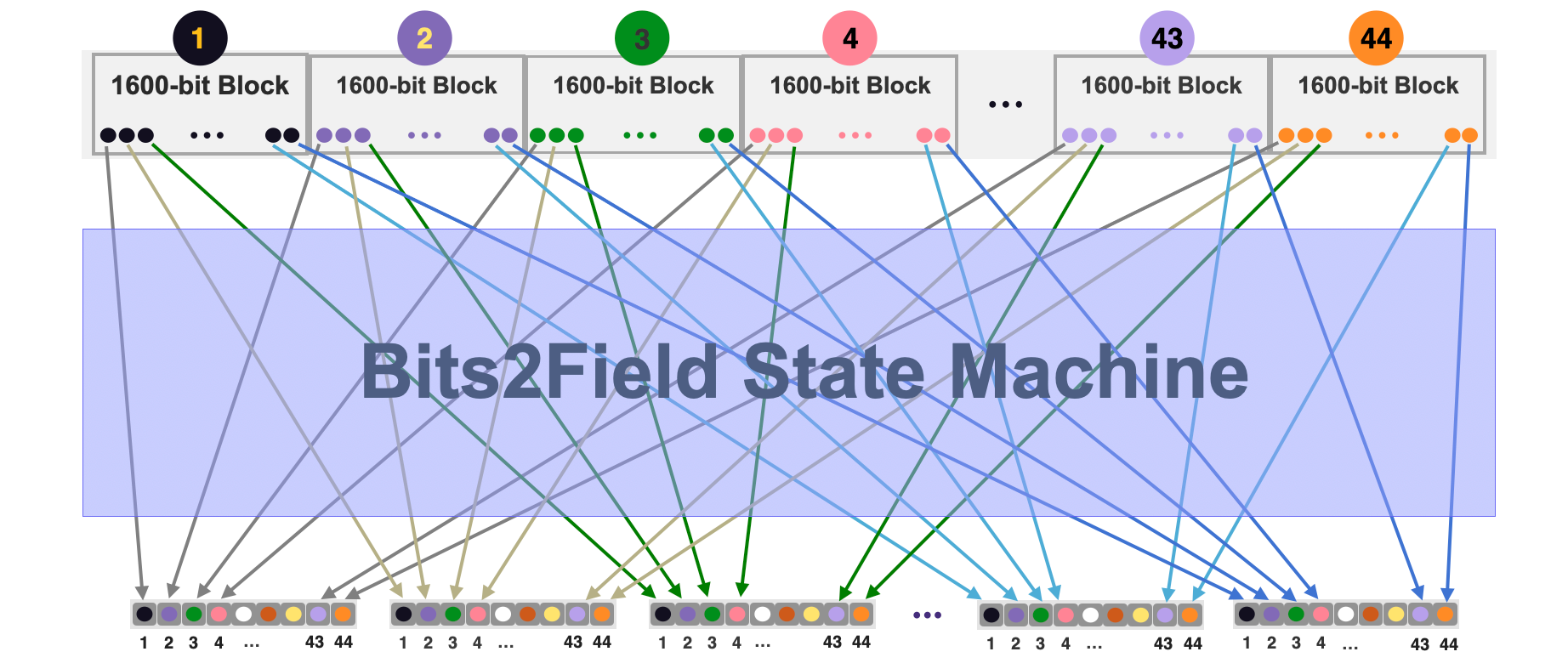Bits2Field state machine
The Bits2Field state machine is one of the auxiliary state machines used specifically for parallelizing the implementation of KECCAK-F SM. Its source code is available here.
The Bits2Field state machine ensures correct packing of \(\mathtt{44}\) bits from \(\mathtt{44}\) different \(\mathtt{1600}\)-row blocks of the Padding-KK-Bit SM into a single field element. Therefore, it operates like a (44 bits to 1 field element) multiplexer between the Padding-KK-Bit SM and the Keccak-F SM.
In simpler terms, it takes bits from \(\mathtt{44}\) different blocks, places them into the first 44 bit-positions of a single field element, whereupon the KECCAK-F circuit runs. The name Bits2Field state machine refers to the processing where \(44\) bits from \(44\) different blocks of the Padding-KK-Bit SM are inserted into a single field element.
Although the KECCAK-F SM is a binary circuit, instead of executing on a bit-by-bit basis, it is implemented to execute KECCAK-F operations on a 44bits-by-44bits basis. This is tantamount to running \(\mathtt{44}\) KECCAK-F hashing circuits in parallel.

Mapping 44 Bits To A 64-bit Field Element¶
Suppose operations are carried out in a field \(\mathbb{F}_p\) of \(\mathtt{64}\)-bit numbers. The smallest field used in the zkProver is the Goldilocks Field \(\mathbb{F}_p\) where \(p = 2^{64} - 2^{32}+1\).
After multiplexing, the 44 bits are loaded into the first 44 least significant bit-positions of the field element as depicted in the figure below.

A field element as an input to the KECCAK-F circuit is of the form,
and it is composed of 20 zeroes and 44 meaningful bits related to the committed polynomials.
Given the capacity of \(2^{23}\) in terms of the state machine evaluations (i.e., the degree of polynomials) and the KECCAK-F’s \(\texttt{SlotSize} = 155286\), one obtains \(2^{23} / 155286 = 54.020375307\) KECCAK-F slots. Therefore, a total of \(54\) slots \(\times\) \(44\) blocks \(= 2376\) Keccak blocks can be processed. This is a big improvement from the previous \(477\) blocks of the 9bits-to-1field element multiplexing (i.e., \(53 \times 9 = 477\)).
The Bits2Field PIL Code¶
The Bits2Field executor executes the multiplexing of forty-four \(\mathtt{1600}\)-bit blocks into \(\mathtt{1600}\) field elements, where each is a \(\mathtt{N}\)-bit field element. For reference, see the above figure where \(\mathtt{N = 64}\).
The question here is how to identify each of the original 9 bits of the field element to track their corresponding resultant \(\mathtt{XOR}\) values or \(\mathtt{ANDP}\) values?
Note that every bit \(\mathtt{b_{i,j}}\) from the \(\mathtt{i}\)-th \(\mathtt{1600}\)-bit block is placed at the \(\mathtt{2^{i}}\)-th position of the \(\mathtt{N}\)-bit field element.
The PIL code therefore uses factors denoted by \(\mathtt{Factor}\), such that \(\mathtt{Factor \in \{ 1, 2, 4, \dots , 2^{43} \}}\), and a \(\mathtt{Fieldlatch}\) after running through forty-four \(\mathtt{1600}\)-bit blocks.
Suppose \(\mathtt{N = 64}\). Then the 44 least significant bits of the \(\mathtt{64}\)-bit field element looks like this:
The constraint checked is therefore,
The accumulated field element at the end of the execution (every forty-fourth row of the execution trace) is checked against the KECCAK-F input \(\mathtt{KeccakF.a}\) with the boundary constraint,
The PIL code is given below.
% "bits2field.pil"
include "keccakf.pil";
namespace Bits2Field(%N);
pol constant FieldLatch; // [0:44,1]
pol constant Factor; // 1,2,4,8,...,2**43
pol commit bit;
pol commit field44;
field44' = (1-FieldLatch)*field44 + bit*Factor;
bit *(1-bit) = 0;
FieldLatch*(field44 - KeccakF.a44) = 0;